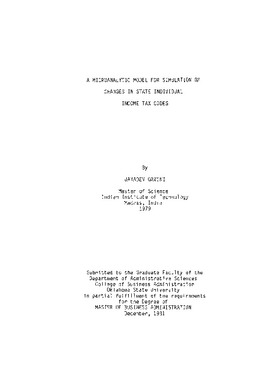| dc.contributor.advisor | Turner, J. Scott | |
| dc.contributor.author | Gavini, Jayadev | |
| dc.date.accessioned | 2016-05-20T20:33:36Z | |
| dc.date.available | 2016-05-20T20:33:36Z | |
| dc.date.issued | 1981-12 | |
| dc.identifier.uri | https://hdl.handle.net/11244/34766 | |
| dc.description.abstract | Scope and Method of Study: The objective of this study is to develop a generalized microanalytic simulation model, which is capable of simulating the aggregate and distributional impact of alterations to federal tax code or any state tax code. Such simulations require a microdata base containing information from individual income tax returns and computer programs to simulate alternative tax structures. The microdata bases used in this study were, the Statistics of Income file, which is a sample of individual tax returns filed with the Internal Revenue Service, for the tax year 1975, giving Oklahoma as the place of residence, and the Survey of Income and Education database, which is a household file complete with records for the household, each family in the household, and person records for each person in the household selected in the sample. The aggregate and distributional impact, of changes in the dividend and interest exclusion limit at the federal level, and a change in the federal tax deduction limit at the state level were simulated for the State of Oklahoma. The same database was used to compute the state tax liability using Kansas, New Mexico and Oklahoma state tax codes. The average state tax liability, aggregate and by income class were examined. | |
| dc.description.abstract | Findings and Conclusions: The increase in the federal interest and dividend exclusion limit reduces the state tax liability of taxpayers in the lower income classes, marginally. The change in the federal tax deduction limit at the state level reduced the aggregate state tax revenue substantially. The average tax liability of people earning more than $5000 reduced substantially. The comparison of the state tax codes of Kansas, New Mexico and Oklahoma, showed that the average state tax liability under the Oklahoma state tax code was the lowest for most of the classes. | |
| dc.format | application/pdf | |
| dc.language | en_US | |
| dc.rights | Copyright is held by the author who has granted the Oklahoma State University Library the non-exclusive right to share this material in its institutional repository. Contact Digital Library Services at lib-dls@okstate.edu or 405-744-9161 for the permission policy on the use, reproduction or distribution of this material. | |
| dc.title | Microanalytic model for simulation of changes in state individual income tax codes | |
| osu.filename | Thesis-1981R-G283m.pdf | |
| osu.accesstype | Open Access | |
| dc.type.genre | Master's Report | |
| dc.type.material | Text | |
| thesis.degree.discipline | Business Administration | |
| thesis.degree.grantor | Oklahoma State University | |
